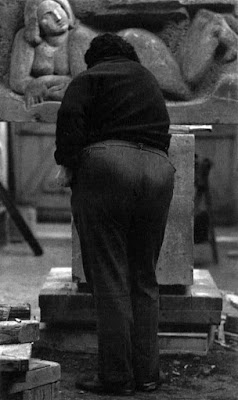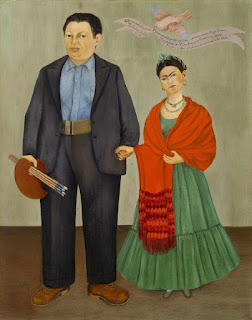Diego Rivera, Mexico City,1924. Photo by Edward Weston. Center for Creative Photography, University of Arizona, Weston Collection.
Knowing of his close friend Diego Rivera's November-December 1930 exhibition at the California Palace of the Legion of Honor and his exciting San Francisco mural commissions, Edward Weston decided come up from Carmel to pay him a surprise visit at his mutual sculptor friend Ralph Stackpole's Jessop Place studio. Weston also wanted to bask in the concurrent exhibition of his own work at the Vickery, Atkins and Torrey Gallery and socialize with photographer friends Ansel Adams, Dorothea Lange and husband Maynard Dixon, and Imogen Cunningham and husband Roi Partridge and others.
Edward Weston and Johan Hagemeyer, Gump's, Feb., 9 to Feb. 21, 1925. Courtesy Center for Creative Photography, Edward Weston Collection.
During a six month interlude in San Francisco during his 1923-26 Mexican sojourn, Weston was one of the first to introduce Rivera and friends to the Bay Area. Through his close photogropher friend Johan Hagemeyer Weston excitedly exhibited his early Mexican work, including the above photo of Rivera, at a two-man show at Gump's Department Store (see above).
Diego Rivera, Frida Kahlo, Timothy Pflueger and Ralph Stackpole, November 10, 1930. Photographer unknown. Courtesy San Franciso Public Library Historical Photograph Collection.
Exhibition Catalogue, Diego Rivera, California Palace of the
Legion of Honor, November 15 to December 25, 1930. Introduction by Katherine
Field Caldwell. From author's collection.
Frontispiece portrait of Diego Rivera, Mexico City, ca. 1923-4 by Edward Weston. (Ibid).
Diego and Frida, Ralph Stackpole's Studio, 27 Jessop Place, San Francisco, December, 1930. Photo by Edward Weston. Center for Creative Photography, University of Arizona, Weston Collection.
Weston fondly wrote of the visit,
"I met Diego! I stood behind a stone block, stepped out as he lumbered downstairs into Ralph [Stackpole]'s courtyard on Jessop Place, - and he took me clear off my feet in an embrace. I photographed Diego again, his new wife - Frieda - too: she is in sharp contrast to Lupe, petite, - a little doll alongside Diego, but a doll in size only, for she is strong and quite beautiful, shows very little of her father's German blood. Dressed in native costume even to huaraches, she causes much excitement on the streets of San Francisco. People stop in their tracks to look in wonder. We ate at a little Italian restaurant [Coppa's] where many of the artists gather, recalled old days in Mexico, with promises of meeting soon again in Carmel. Pfleuger - architect - was another contact worthwhile. He sat to me - on the roof of Ralph's." (The Daybooks of Edward Weston, Volume II, California, pp. 198-9. For much more on Coppa's and fellow Mexican muralist Jose Clemente Orozco's happy times there see my "Orozco in San Francisco, 1917-1919").
Frida Kahlo, Ralph Stackpole's Studio, 27 Jessop Place, San Francisco, December, 1930. Photo by Edward Weston. Center for Creative Photography, University of Arizona, Weston Collection.
Diego Rivera, Ralph Stackpole's Studio, 27 Jessop Place, San Francisco, December, 1930. Photo by Edward Weston. Center for Creative Photography, University of Arizona, Weston Collection.
Lady Hastings, San Francisco, ca. 1930. Photo by Edward Weston from The San Franciscan, April 1931, p. 21.
The wife of Lord Hastings, one of Rivera's mural assistants, also sat for a portrait while Weston was in town. It was published in the April 1931 issue of The San Franciscan with the caption,
"Lady Hastings who is being widely entertained during her sojourn in San Francisco, while her husband, Lord Hastings, assists Diego Rivera with fresco panels in the Stock Exchange and the California School of Fine Arts."
Storer House, 8161 Hollywood Blvd., Hollywood, Frank Lloyd Wright, architect, 1924.
Weston made prints of his San Francisco reconnection with Rivera before heading south for the holidays to visit the family. Brett, who had recently established his first independent studio in Frank Lloyd Wright's Storer House (see above) through the largess of Pauline Schindler, picked up his father in Carmel and drove him back to Los Angeles. (For more detail see my "Brett Weston's Smokestacks and Pylons").
"Toward the Big Sur" by Edward Weston, The Carmelite, May 2, 1929. Courtesy Harrison Memorial Library, Carmel.
While in Southern California Weston hooked up with close friends Johan Hagemeyer, Merle Armitage and Ramiel McGehee and visited Pauline at the Storer House. She had herself recently returned from a two year sojourn in Carmel where she edited and published the local progressive weekly newspaper, The Carmelite in which she frequently featured the work of Weston (see above for example). He shared with her his prints of Rivera and other recent work prompting her to recommend he send them off to various suggested publications. (For much more on Pauline's marketing efforts on behalf of the artists and architects in her wide circle see my "Pauline Gibling Schindler: Vagabond Agent for Modernism").
Diego Rivera, Ralph Stackpole's Studio, 27 Jessop Place, San Francisco, December, 1930. Photo by Edward Weston. Center for Creative Photography, University of Arizona, Weston Collection.
Of the Rivera prints she recommended,
"i think also that the Rivera pictures should be used now while the san francisco work is hot. why not send it to "creative art?" or "the international studio?" or whatever publication you consider superlative in that line. or send the glossy to me, and i will send it to where you suggest, with a brief accompanying article. how about sending the rivera beside mop and garbage can (see above) to "the new masses?" please let me know exact details as much as possible of the s. f. paintings of rivera for my articles." (Pauline Schindler to Edward Weston, February 13, 1931. Center for Creative Photography, Weston Papers).
Pauline would have been dying to meet Rivera knowing full well of his politics from Weston and former Schindler House tenant and Blue Four art dealer Galka Scheyer and the news media. She would meet Rivera through Scheyer and mutual friend Marjorie Eaton on a trip to the Bay Area two weeks later. (Ibid).
Galka Scheyer had been staying with Pauline and Brett and perhaps crossed paths with mutual friend Weston when she visited Rivera in San Francisco to solicit his co-sponsorship for her upcoming Blue Four exhibition at the California Palace of the Legion of Honor in April. (For much more on the Scheyer-Rivera connection see my "Schindler-Scheyer-Eaton-Ain: A Case Study in Adobe").
(Author's note: Brett Weston had photographed Mexican muralist amigo Jose Clemente Orozco in the spring of 1930 while he was creating his Prometheus mural at Pomona College. His father photographed him in Carmel during a July visit with his dealer Alma Reed while they were in San Francisco scouting for mural walls and preparing for his upcoming exhibition at the Metropolitan Museum of Art in New York). (For more details on Orozco's 1930 California visit see my "Brett Weston's Smokestacks and Pylons," "Richard Neutra and the California Art Club" and "Orozco in San Francisco, 1917-1919").
(Author's note 2: In November of 1931 a portrait of Frieda and Diego Rivera painted by "Senora Frieda Rivera" of Mexico City during their 1930-31 stay in San Francisco (see above) was selected for the juried Sixth Annual Exhibition of the San Francisco Society of Women Artists at the Legion of Honor. This was the first public showing of Frida Kahlo's work). ("Art and Artists," Oakland Tribune, November 8, 1931, p. 22). (For much more on this see my "Schindler-Scheyer-Eaton-Ain: A Case Study in Adobe").
Frieda and Diego Rivera, 1931 by Frieda Kahlo. Courtesy FridaKahlo.org.
(Author's note 2: In November of 1931 a portrait of Frieda and Diego Rivera painted by "Senora Frieda Rivera" of Mexico City during their 1930-31 stay in San Francisco (see above) was selected for the juried Sixth Annual Exhibition of the San Francisco Society of Women Artists at the Legion of Honor. This was the first public showing of Frida Kahlo's work). ("Art and Artists," Oakland Tribune, November 8, 1931, p. 22). (For much more on this see my "Schindler-Scheyer-Eaton-Ain: A Case Study in Adobe").
Lovell Beach House, Newport Beach, R. M. Schindler, architect, 1926. Photo by Edward Weston, August 2, 1927. Courtesy UC-Santa Barbara Architecture and Design Collections, Schindler Papers.
The material in this and linked posts will be part of a larger project, "The Schindlers and the Westons: An Avant-Garde Friendship" (see above).













